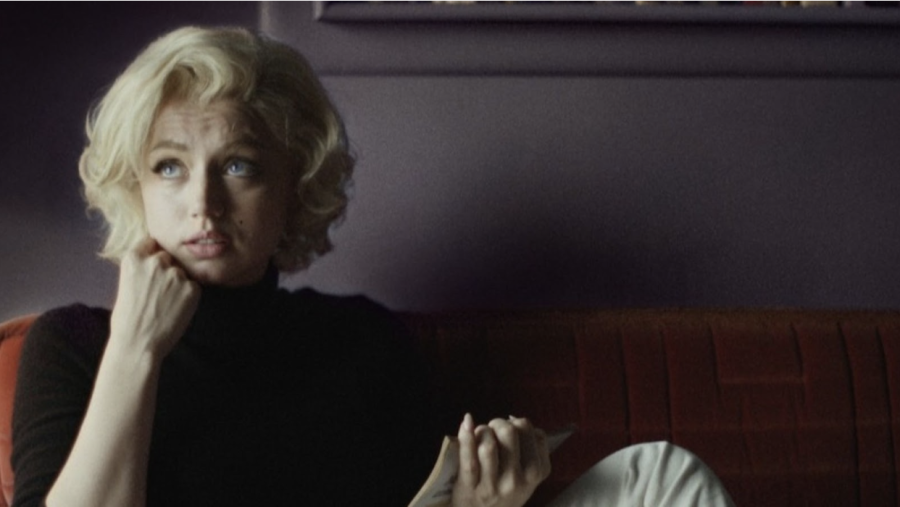Critics slammed Andrew Dominik’s newest film, “Blonde” at its release, with the movie only receiving more backlash when it was added to Netflix Sept. 28. After watching, I found it hard to disagree with the criticism.
Netflix claims the film is a “fictional portrait of Marilyn Monroe that boldly reimagines the tumultuous private life of the Hollywood legend,” but the depiction of Monroe lacks empathy, and only a small fraction of the film stays true to Monroe’s life.
Monroe’s character is portrayed as a desperate, tortured airhead who becomes a punching bag for other characters in the movie. The film starts by exploring Monroe’s childhood, graphically depicting her relationship with her abusive mother. Her mother’s verbal and physical assault culminates in an attempt to drown Monroe in a scalding bath. As shown in the film, Monroe’s birth mother had schizophrenia and was institutionalized when Monroe was 7-years-old.
However, according to Time Magazine, there was no attempted drowning in real life. The exaggerations do not stop there. In fact, the recurring theme of fabricated trauma is only further perpetuated. For example, the film depicts the head of 20th Century Fox assaulting Monroe and her receiving a breakout role in return.
The film neglects her talent and any autonomy she had over her line of work.
By inventing this traumatic assault, Dominik implies that Monroe’s experience of being aggressively violated catalyzed her career. The film neglects her talent and any autonomy she had over her line of work, instead attributing the start of her success to the despicable actions of a man.
The rest of “Blonde” follows the trend of Monroe’s legacy being based on her abusive relationships with men. The film places her in a fictional relationship with Charlie Chaplin’s son, in which she is mistreated and used for her fame. This relationship leads to an unintentional pregnancy and a traumatic abortion scene that follows. The scene comes off as blatant anti-abortion propaganda by including disturbing shots of the fetus begging Monroe to stop the procedure.
Scenes of the aborted fetus are recurring throughout the rest of the movie, guilting Monroe for her decision. The invasive, violating scenes are even more uncomfortable to watch as the real Monroe struggled with multiple failed pregnancies due to her endometriosis, which can cause infertility. The choice to portray her abortion instead of diving into her infertility demonstrates that Domnik was more interested in guilting Monroe’s character and villainizing her fictional decision rather than presenting a holistic and accurate portrait.
In the second half of the film, “Blonde” shifts from an anti-abortion focus to delve into Monroe’s famous, rumored affair with U.S. President John F. Kennedy. Instead of showing how Monroe’s intelligence and charm aided her creation of a relationship with one of the most powerful men in the world, the film continues to paint her as a ditzy, desperate woman who would do anything for male approval.
Further, Monroe is taken advantage of in her relationships throughout. Dominik’s story arc also insinuates that her trauma stems from her father abandoning her, again relating life to the actions of a man.
The final part of the movie a tortured Monroe, suicidal and depressed after she finds out the father she never knew died.
Monroe’s fatal overdose ends the film, concluding on a deeply disturbing note as a smiling version of her body is layered underneath her corpse. By leaving viewers with an image of only being able to achieve peace in death, Monroe’s life is reduced to a cycle of abuse and trauma. In addition, I found the scene to be even more disrespectful when I found out it was filmed at the location of Monroe’s actual death in 1962, creating a connection between Dominik’s fictional vision and Monroe’s real life.
While the aesthetic pleasure of the film temporarily distracts from the lackluster plotline, it is impossible to overlook the obvious exploitation of Monroe’s legacy.
While the film itself was disappointing, the acting performances were incredible. The casting of Ana de Armas as Monroe contained so much potential. In “Blonde,” she delivered her scenes as if she had completely embodied the character assigned.
Ultimately, the issue with “Blonde” lies in the writing of Monroe’s character and how it exploits the image of a real person. The cinematography and visuals are appealing, but the disturbing and inaccurate themes take away from the artistry. While the aesthetic pleasure of the film temporarily distracts from the lackluster plotline, it is impossible to overlook the obvious exploitation of Monroe’s legacy. This image is the polar opposite of the real Marilyn Monroe, who was known for having autonomy over her career and asserting her power in both relationships and business.
The exploitation of women in the spotlight is not unheard of, but “Blonde” takes it to a disgusting extent by fabricating traumatic situations and dropping a real person into these scenarios. By manipulating the traumas of a dead woman, the film denies Monroe of maintaining any power over her image.






